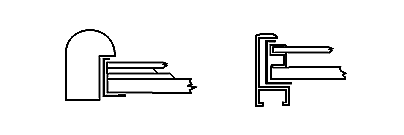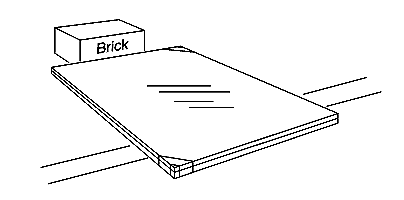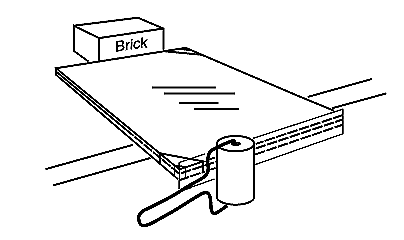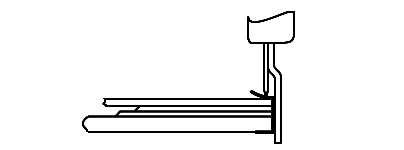Jan 20th 2016
Stopping the Dust Pump
The typical frame with glass, mats (or spacers) makes a very efficient diaphram pump. Any movement of either the glass or the backing will pump air in and out of the frame. The following is a collection of information I have amassed over a 30 year involvement with framing and I thought it important enough to share. I haven't found any papers or test reports on this subject but if you know of any, please share with the rest of us.
The typical frame with glass, mats (or spacers) makes a very efficient diaphram pump. Any movement of either the glass or the backing will pump air in and out of the frame. Just turning a frame over on the fitting table will cause the air to move in and out of the frame.
Depending which element is more flexible, the glazing or the backing can be the pump. Any air forced out will be countered by an equal amount sucked in. ( Figs. 1 & 2.)
Unfortunately, this moving air moves right past the edge of both the glass and the mat/backing package. (Even if you put a dust cover or tape on the back of the frame.) You spend all that time getting everything clean before you fit the frame and there's still dust. Where does it come from and how can you stop it? Here are some typical hiding places for frame debris:
- The core of the outside edges of mats, foam board, or other backing boards.
- Any wood fibers, gold leaf, or paint flakes in the rabbet of a wood frame.
- Any glass chips created when fitting a metal frame.
- Freshly shredded glass clean rag fibers stuck to the edge fo the glass (We never really do look there, do we?)


Fig. 1. More flexible backing acting as the pump.

Fig 2. More flexible glazing acting as the pump.
It's unrealistic to think that you can clean everything perfectly in the time alloted. Painting, taping, or otherwise sealing the rabbet on wood frames will undoubtedly help but the pump is still working against you. A lot of framers solve this dust problem by tape sealing the glass-mat-backing package before it goes into the frame. ( See Figure 3.)

Fig 3. Cross section of tape sealed glass-art-backing packages in typical frames. (Shown expanded for clarity.)
There are several hidden benefits to tape sealing a frame:
- Tape sealing will effectively turn off the dust pump.
- It will stop the intrusion of any new outside dust, smoke, bugs, or pollution.
- Any particles coming out of the mats, foam board, or backing materials will get stuck to the sticky side of the tape.
- If done well it may even prevent glass cleaner from wicking up between the glass and the front mat. (Do you think they will ever learn?)
- Tape sealing slows down any rapid change of the humidity level of materials inside the frame. This will help prevent buckling of paper art and matboards.
Some of the arguments I've heard against tape sealing:
- Tape sealing takes to much time. (Not as much time as unfitting and refitting a frame to chase dust particles.)
- If you ever have to open up a taped frame job, it's a real mess. (Not if you use a tape that doesn't tear as you remove it as it will all come off at once.)
- Some argue that humidity accumulates in a tape sealed frame over time. (I have not seen this phenomenon nor any scientific test to substantiate this claim. Have you ever opened an old frame and found it damp?)
- Some believe that tape sealing a frame will cause any humidity to condense on the glass or art if the frame gets hot. (Like in the sun.) Tape or no tape, the results will probably be the same as there are no real forces that will act to remove humidity from the materials in an unsealed frame.
- Some believe that any bad stuff sealed into the frame cavity will harm the art. (I wonder what forces make the bad stuff migrate out of a frame that's not tape sealed. I also wonder which is worse; The bad stuff in the frame or pollution, bugs, dust, and smoke that could get into an untaped frame.)
- Some believe that the acrylic adhesive out gasses chemicals that are detrimental to the art in a frame. Don't "Encapsulators" use acrylic adhesive? Do you use any other acrylic adhesives (ATG tape) within a frame cavity?
Tape is an additional cost. This is more than offset by the labor saving of not having to open up just one frame a day. (Besides, what is the fitting charge supposed to pay for ?)
Nevertheless, when you determine it is appropriate to seal a frame job, here are some tricks that make tape sealing a frame quick, neat, and easy:
After cleaning all the components, stack up the clean glass-mat-art-backing package face up out over the edge of the table and hold it all aligned with pieces of tape diagonally across two corners as show in Figure 4.
The brick is like a third hand. Don't worry about the tape across the corners as it will be easily removed during the last step.

Fig. 4. Hold the glass-art-backing package aligned with tape diagonally across two diagonally opposed corners.
As you apply the tape around the edges, let about 1/4" stick up above the glass. (See Figure 5.) Leave it standing straight up at this point. You don't have to be accurate at this point as it will be trimmed to 1/16" in the next step.

Fig. 5. Apply the tape to the edge of the glass-art-backing package leaving about 1/4" of tape sticking straight up.
Use your hand or a soft rubber brayer to stick the tape to the back and outside edge of the whole package. (See figure 6.)

Fig. 6. Use a soft rubber roller to press the tape onto the edge of the glass-art-backing package.
Cut through the tape on the front of the glass about 1/16" from the edge. Use a dust cover trimmer (Like a ProTrim knife) or a razor blade.

Fig. 7. Roll the side, back, and just a little of the tape on the front of the glass. Cut through the tape about 1/16" from the edge with a dust cover trimmer.
Pull up the 3/16" or so of excess tape leaving a neatly trimmed edge. This 1/16" of tape left on the front of the glass will not show under the lip of the frame unless the frame allowance is too large or the rabbet width is too narrow.
That's it! No big deal! I believe that you have just saved yourself a lot of very frustrating time chasing dust and you've given your customer a better frame job.


